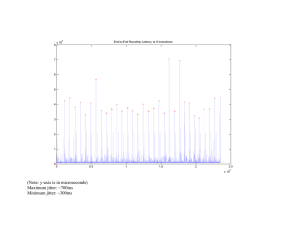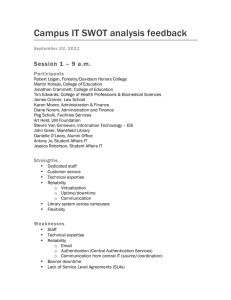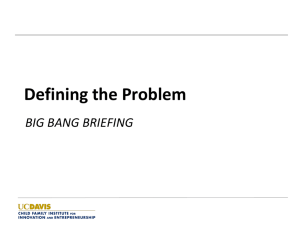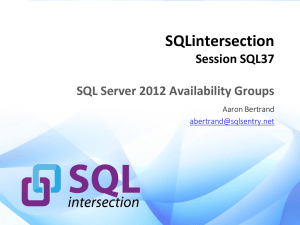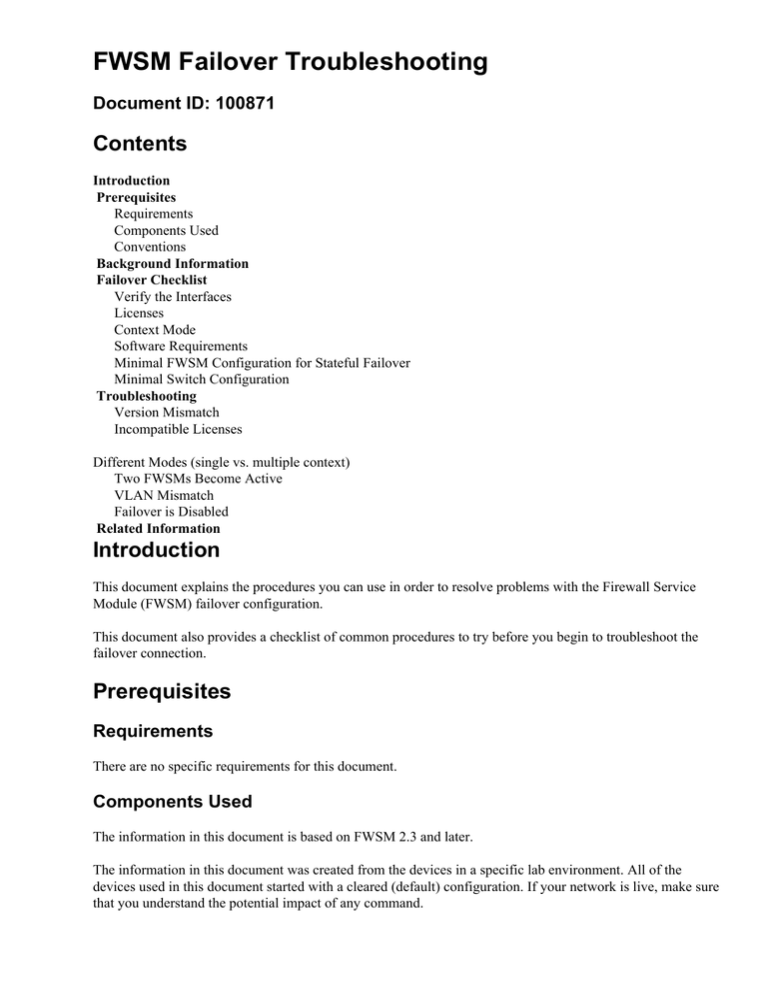
FWSM Failover Troubleshooting
Document ID: 100871
Contents
Introduction
Prerequisites
Requirements
Components Used
Conventions
Background Information
Failover Checklist
Verify the Interfaces
Licenses
Context Mode
Software Requirements
Minimal FWSM Configuration for Stateful Failover
Minimal Switch Configuration
Troubleshooting
Version Mismatch
Incompatible Licenses
Different Modes (single vs. multiple context)
Two FWSMs Become Active
VLAN Mismatch
Failover is Disabled
Related Information
Introduction
This document explains the procedures you can use in order to resolve problems with the Firewall Service
Module (FWSM) failover configuration.
This document also provides a checklist of common procedures to try before you begin to troubleshoot the
failover connection.
Prerequisites
Requirements
There are no specific requirements for this document.
Components Used
The information in this document is based on FWSM 2.3 and later.
The information in this document was created from the devices in a specific lab environment. All of the
devices used in this document started with a cleared (default) configuration. If your network is live, make sure
that you understand the potential impact of any command.
Conventions
Refer to Cisco Technical Tips Conventions for more information on document conventions.
Background Information
The failover feature allows a standby FWSM to take over the functionality of a failed FWSM. The two
FWSMs involved must have the same major (first number) and minor (second number) software version,
license, and operating modes (routed or transparent, single or multiple context). When the active unit fails, the
state changes to standby, while the standby unit moves into the active state. After a failover occurs, the same
connection information is available at the new active unit.
For additional information, refer to the Configuring Failover section of Using Failover.
Failover Checklist
This checklist helps you to successfully configure the failover in FWSM:
• Verify the Interfaces
• Licenses
• Context Mode
• Software Requirements
• Minimal FWSM Configuration for Stateful Failover
• Minimal Switch Configuration
Verify the Interfaces
Verify that all interfaces on the FWSM have a configured standby IP address. If you have not done so already,
configure the active and standby IP addresses for each interface (routed mode), or for the management address
(transparent mode). The standby IP address is used on the FWSM that is currently the standby unit. It must be
in the same subnet as the active IP address.
This is an example configuration:
ip address <active−ip> <netmask> standby <standby−ip>
Note: Do not configure an IP address for the failover link or for the state link (if you are going to use Stateful
Failover).
Note: You do not need to identify the standby address subnet mask. The failover link IP address and MAC
address do not change at failover. The active IP address for the failover link always stays with the primary
unit, while the standby IP address stays with the secondary unit.
Licenses
Both active and standby units must have the same license.
Context Mode
If the primary unit is in single context mode, the secondary unit must also be in single context mode and in the
same firewall mode as the primary unit.
If the primary unit is in multiple context mode, the secondary unit must also be in multiple context mode. You
do not need to configure the firewall mode of the security contexts on the secondary unit because the failover
and state links reside in the system context. The secondary unit obtains the security context configuration
from the primary unit.
Note: The mode command does not get replicated to the secondary unit.
Note: Multicast is not supported in the multiple context mode of the security appliance. Refer to the
Unsupported Features section for more information.
Software Requirements
The two units in a failover configuration must have the same major (first number) and minor (second number)
software version. However, you can use different versions of the software during an upgrade process. For
example, you can upgrade one unit from Version 3.1(1) to Version 3.1(2) and have failover remain active.
Cisco recommends to upgrade both units to the same version to ensure long−term compatibility.
Minimal FWSM Configuration for Stateful Failover
Primary FWSM
failover
failover
failover
failover
failover
lan unit primary
lan interface if_name vlan vlan
interface ip if_name ip_addr mask standby ip_addr
link if_name vlan vlan
interface ip if_name ip_addr mask standby ip_addr
Secondary FWSM
failover
failover
failover
failover
failover
lan unit secondary
lan interface if_name vlan vlan
interface ip if_name ip_addr mask standby ip_addr
link if_name vlan vlan
interface ip if_name ip_addr mask standby ip_addr
For more information on how to configure Active and Standby failover, refer to Configuring Active/Standby
Failover.
Minimal Switch Configuration
• The VLANs sent to the primary FWSM by the Catalyst that contains the primary must match the
VLANs sent to the secondary FWSM by the Catalyst that contains the secondary. (Output of the show
run | i firewall command must be identical.)
Primary Chassis
cat6k−7(config)#do sh run | i fire
firewall multiple−vlan−interfaces
firewall module 9 vlan−group 1
firewall vlan−group 1 3,4,100−106
Secondary Chassis
cat6k−7(config)#do sh run | i fire
firewall multiple−vlan−interfaces
firewall module 9 vlan−group 1
firewall vlan−group 1 3,4,100−106
• All the VLANs that are sent must be present in the VLAN database and be active.
In order to perform this, issue these commands on the switch in configuration mode:
vlan 10
no shut
In order to verify if the VLANs are in the database and active, the output of the show vlan command
on both chassis must contain the VLANs sent to the FWSM and show as active.
This is a sample output:
Primary Chassis
cat6k−7(config)#do sh vlan
VLAN
−−−−
1
3
4
Name
−−−−−−−−−−−−−−−−−−−−−−−−−−−−−−−−
default
VLAN0003
VLAN0004
Status
Ports
−−−−−−−−− −−−−−
active
active
Fa4/47
active
Fa4/48
Secondary Chassis
cat6k−7(config)#do sh vlan
VLAN
−−−−
1
3
4
Name
−−−−−−−−−−−−−−−−−−−−−−−−−−−−−−−−
default
VLAN0003
VLAN0004
Status
Ports
−−−−−−−−− −−−−−
active
active
Fa4/47
active
Fa4/48
• Make sure that the two FWSMs have Layer2 connectivity in each VLAN (they must be in the same
subnet).
Transparent Firewall Requirements:
In order to avoid loops when you use failover in transparent mode, you must use switch software that
supports Bridge Protocol Data Unit (BPDU) forwarding. Also, you must configure the FWSM to
allow BPDUs. In order to allow BPDUs through the FWSM, configure an EtherType? ACL and apply
it to both interfaces.
Note: As opposed to the PIX and ASA platform, the hardware of two FWSM blades is always the
same, there are no different models or memory configurations.
Troubleshooting
When the FWSM reloads, the scenarios explained in this section will cause failover to be disabled.
The FWSM can reload for reasons such as crash, reset from chassis, reload issued from FWSM CLI, or it can
just be a new module that is inserted or reseated into a different slot or powered back up from the chassis.
Version Mismatch
The two units in a failover configuration must have the same major (first number) and minor (second number)
software version.
Related syslog message: 105040
Incompatible Licenses
You might receive this syslog because of an incompatible license:
FWSM−1−105045: (Primary) Mate license (number contexts) is not compatible
with my license (number contexts).
FWSM−1−105001: (Primary) Disabling failover.
Related syslog messages: 105045 and 105001
Different Modes (single vs. multiple context)
Both the primary and secondary FWSM must be in the same mode (single or multiple). For example, if the
primary is configured as single mode and the secondary as multiple mode and the secondary is reloaded, then
both the modules will turn off failover.
Primary in single mode:
%FWSM−1−103001: (Primary) No response from other firewall (reason code = 1).
%FWSM−1−105044: (Primary) Mate operational mode (Multi) is not compatible
with my mode (Single).
%FWSM−1−105001: (Primary) Disabling failover.
Secondary in multiple mode (this blade is reloaded):
%FWSM−5−111008: User 'Config' executed the 'no snmp−server location' command.
%FWSM−5−111008: User 'Config' executed the 'inspect tftp' command.
%FWSM−5−111008: User 'Config' executed the 'service−policy global_policy global'
command.
%FWSM−5−111008: User 'Config' executed the 'config−url disk:/admin.cfg' command.
%FWSM−5−111008: User 'Config' executed the 'prompt hostname context' command.
%FWSM−4−411001: Line protocol on Interface LAN, changed state to up
%FWSM−4−411001: Line protocol on Interface LAN, changed state to up
%FWSM−1−105044: (Secondary) Mate operational mode (Single) is not compatible
with my mode (Multi).
%FWSM−1−105001: (Secondary) Disabling failover.
%FWSM−6−199002: Startup completed. Beginning operation.
%FWSM−6−605005: Login permitted from 127.0.0.51/15518 to eobc:127.0.0.91/telnet
for user ""
%FWSM−5−502103: User priv level changed: Uname: enable_15 From: 1 To: 15
%FWSM−5−111008: User 'enable_15' executed the 'changeto context admin' command.
Primary in multiple mode:
%FWSM−1−105044: (Primary) Mate operational mode (Single) is not compatible
with my mode (Multi).
%FWSM−1−105001: (Primary) Disabling failover.
Related syslog messages: 105044, 103001, 105001
Two FWSMs Become Active
When you see this error message in the log:
fw_create_pc_sw: fw_create_portchannel failed
The reason for this error is because the recommended number of port−channels in the switch exceeded the
maximum (128 is maximum in Cisco IOS software release12.2(33)SXH4 on Cat6000/6500). Therefore,
Interface Descriptor Block (IDB) limit is being exhausted.
Because of this, you might end up with these two issues:
• When you have two switches with FWSM modules each to act as active and standby, two FWSM
modules become active at the same time.
• You cannot create an additional port−channel.
As part of resolving the issue, delete the port−channels that are not needed and reload the FWSMs.
VLAN Mismatch
Problem
The FWSM receives this error message: 'Detected an Active Mate' 'Vlan configuration mismatch' 'failover
will be disabled'.
OR
The configuration of the firewall service modules and the corresponding switch configuration appear to be
complete. However, the FWSMs are unable to sync each other. This message is received on the secondary
host:
State check detected an Active mate
Unable to verify vlan configuration with mate.
Check that mate's failover is enabled
No Response from Mate
OR
The output of the show failover command shows the failover status on secondary module is OFF, FWSM
failover state in Failover Off (pseudo−Standby).
FWSM−secondary(config)#show failover
Failover Off (pseudo−Standby)
Solution
The problem might be the mismatch VLAN assignment across the firewall (FWSMs and supervisors). For
example, in the Firewall vlan−group 1 statement, the same number of VLANs assigned on each switch to the
firewall can vary. This might cause the issue. If you assign the same number of VLANs in the firewall, then
failover will work.
In order to avoid getting a VLAN configuration mismatch error, the show vlan command output must be
identical on both FWSMs. This error message only occurs when you modify or load the failover configuration
on the FWSM. For example, when a FWSM boots it loads the startup−config from the flash and attempts to
initialize failover. At this time, it checks to make sure both modules are receiving the correct VLANs. If the
VLANs do not match, the error message is displayed and failover remains disabled.
Note: For failover to work, the FWSM requires identical configurations and port assignments. It is possible to
do inter−chassis failover, but each VLAN assigned to the firewall must be in the trunk between the two
chassis.
FWSM does not include any external physical interfaces. Instead, it uses VLAN interfaces. Assigning VLANs
to the FWSM is similar to assigning a VLAN to a switch port. The FWSM includes an internal interface to the
Switch Fabric Module (if present) or the shared bus. For more information, refer to Assigning VLANs to the
Firewall Services Module.
Be aware that the VLAN mapping can get modified during a working FWSM setup and will fail during next
boot.
Failover is Disabled
When you disable the failover using the no failover command, the current state of the unit is maintained
(whether active or standby) until the unit gets reloaded. This is used only to disable the failover. In order to
change the state of the unit from active to standby or vice versa, you need to use the [no] failover active
command.
Related Information
• FWSM: Configuring Failover
• FWSM: System Log Messages
• Technical Support & Documentation − Cisco Systems
Contacts & Feedback | Help | Site Map
© 2014 − 2015 Cisco Systems, Inc. All rights reserved. Terms & Conditions | Privacy Statement | Cookie Policy | Trademarks of
Cisco Systems, Inc.
Updated: Mar 21, 2008
Document ID: 100871

